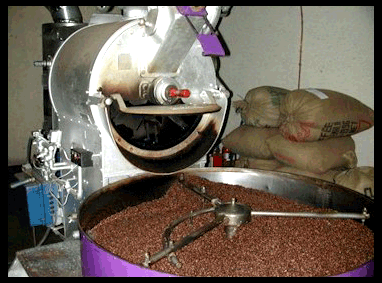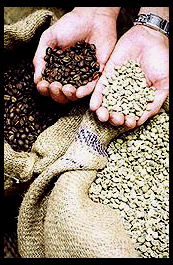Roasting
After quality coffee beans are obtained, the most important phase of the production of gourmet coffee begins, the roasting and the blending.
 A good roaster must be part artist, and part scientist, to maintain quality and consistency. It is during the roasting process that the sugars and other carbohydrates within the bean become caramelized, creating a substance which is known as the coffee oil. Technically, this fragile chemical is not actually an oil (since it is water soluble), but it is what gives the coffee its flavor and aroma.
A good roaster must be part artist, and part scientist, to maintain quality and consistency. It is during the roasting process that the sugars and other carbohydrates within the bean become caramelized, creating a substance which is known as the coffee oil. Technically, this fragile chemical is not actually an oil (since it is water soluble), but it is what gives the coffee its flavor and aroma.
Specialty coffees are generally roasted in small batches. The two most common roasting methods are: drum-roasting and hot-air roasting.
Drum-type roasting machines roast the coffee beans as they tumble in a rotating drum that is typically heated by gas or wood.
When the desired roast is achieved, the beans are poured into a cooling hopper to keep them from overcooking.
The hot-air roaster, also known as a fluid-bed roaster, roasts the coffee beans as they tumble on a current of hot air.
Most green coffee is roasted at approximately 400 degrees. The roasting process causes the coffee beans to swell and increase in size by over 50%, while at the same time greatly reducing their weight.
A lightly roasted bean may range in color from cinnamon to a light chocolate tan. Lighter roasts are generally used for brewed coffee since they produce a smoother, more acidic taste than do darker roasts.
 Darker roasts, in contrast, have a fuller flavor approaching a bittersweet tang. The amount of oil drawn to the surface of the bean increases proportionately to the length of roasting time.
Darker roasts, in contrast, have a fuller flavor approaching a bittersweet tang. The amount of oil drawn to the surface of the bean increases proportionately to the length of roasting time.
As the roast darkens, caffeine and acidity decrease proportionately. Dark roasts can range in color from a medium chocolate brown with a satin-like luster, to an almost black bean with an oily appearance. The darker the roast the more you will taste the char, rather than the flavor of the bean.
Extreme dark roasts will tend to have a smoky flavor, and are better suited for espresso.
Many roasters refer to the following terms concerning the degree of roast, from light to dark: Cinnamon, Medium High, City, Full City, French, and finally, Espresso or Italian roast.
French roast is the term sometimes used to describe the darkest roast. It is important for you to understand that these terms have no relationship to where the coffee is grown or roasted.
With more than 100 coffee-growing regions in the world, each producing beans with distinctive characteristics, we believe proper blending is essential to the balance of flavors necessary to create a superior cup of coffee.
A single coffee bean will generally not possess the complexity necessary for a great brew. All of our Black Diamond Coffee blends contain three to seven different types of beans. Even our Black Diamond 100% Colombian utilizes beans from 3 totally distinct growing areas of Colombia.
Our experienced roaster, with his knowledge of each bean, artfully combines them to create the desired blend of flavors. The roaster's blending knowledge is a closely guarded secret.
In the United States, 100% Arabica beans are generally used for gourmet blends, although with some companies some Robusta beans will be added for the additional caffeine, complexity, and price advantage they contribute to the blend.
Argument still exists among roasters as to which should occur first, the roasting or the blending. We believe roasting each varietal separately to maximize its flavor characteristics, and then blending, will produce the best result.
Freshly roasted beans will release hundreds of chemical substances in the form of vapors. A day or two will generally be required for these gases to dissipate before the beans will reveal their optimal flavor characteristics.
Today, quality roasters are packaging their beans in air tight bags with a one way valve, which allows the gases to escape, without the beans being exposed to the damaging air. This type of package helps retard flavor deterioration.
If beans are not packaged this way, or once beans packaged air tight are exposed to the air, they will begin to deteriorate. Roasts where oils are exposed on the surface of the bean are much more vulnerable.
Once exposed to the air, and if properly stored, beans will stay reasonably fresh for 7 to 10 days. We recommend storing beans in a clean, dry, air-tight container, in a cool dark place.
We do not recommend storing beans in a refrigerator unless they are in a sealed container, because coffee tends to absorb flavors. Freezing coffee beans can also have a damaging effect, and is not recommended, unless the beans must be stored for a prolonged period of time.
Ideally, you should strive to purchase and use-up your supply of roasted beans on a weekly basis.
